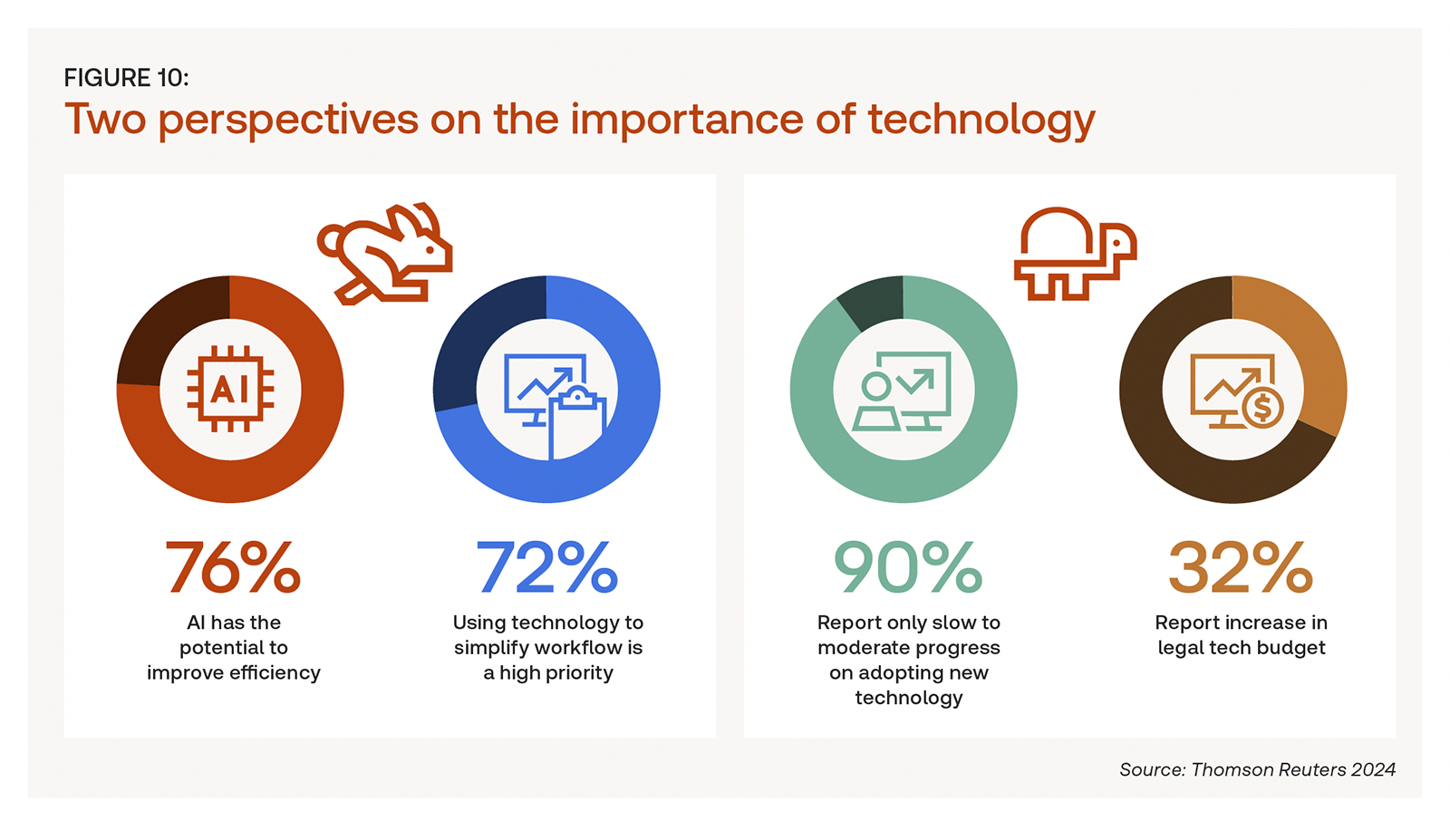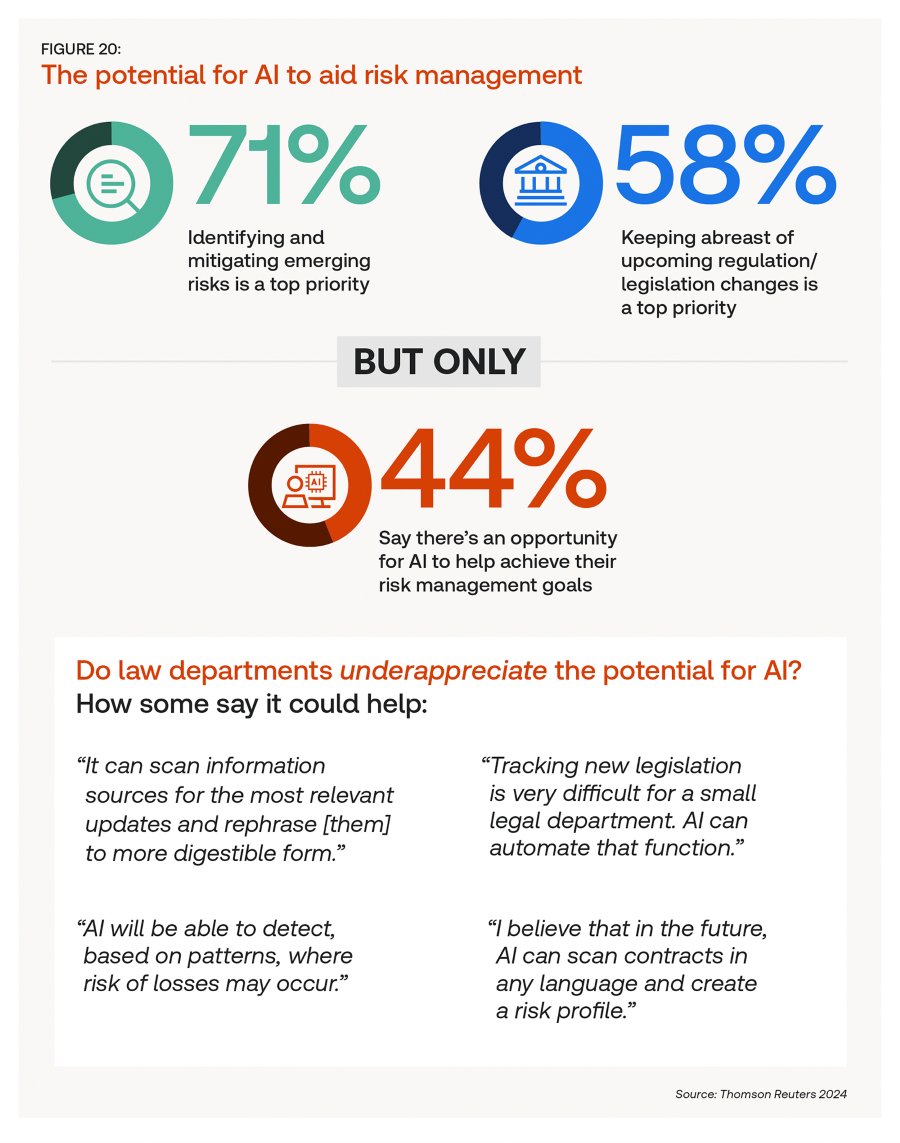In-house lawyers find themselves jammed between problems that AI might solve and their comfort and ability to adopt AI solutions
There is near universal agreement that the rise in new artificial intelligence (AI) technologies presents both opportunities and risks for businesses. The same is true within the in-house law departments that serve those businesses.
This duality is part of the reason why so many corporate general counsel (GCs) are taking a bit of a wait-and-see approach to rolling out these new technologies within their departments, especially when it comes to the use of generative AI (GenAI). That’s not to say they’re completely sitting on their hands. In fact, according to Thomson Reuters recently released Future of Professionals 2024 report, one-third of GCs surveyed said believe that AI will enable them to bring more work in house in the next five years.
However, to arrive at that point in the future, today’s GCs will have to navigate a few tricky crossroads which exist in their current reality.
Two perspectives on technology
Earlier this year, we reported on an interesting bifurcation in the technological reality of today’s GC.

On the one hand, nearly three-quarters of GCs recognize that AI has the potential to improve efficiency. Nearly as many say that using technology to simplify their workflows is a high priority for their departments. Both of these are very understandable findings.
GCs have spoken for years about the pressure they feel to do more with less and to bring costs under control. Key to both of these goals is optimizing the capacity of in-house staff — and that means making sure that each staff member creates as much value as possible out of each working hour. Leveraging technology to improve efficiency and simplify workflows is a seemingly obvious way to fulfill these goals; streamlined workflows create better efficiency, which in turn allows more time for the in-house legal team to conduct more higher-value work, thereby reducing the company’s reliance on expensive outside counsel.
However, there is a potential contrast that is reducing the impact of this forward motion.
While GCs recognize the potential for AI to help reach certain goals, they also report slow adoption of new technology and a potential lack of budget resources to pay for it.
Nearly three-quarters of GCs recognize that AI has the potential to improve efficiency, and nearly as many say that using technology to simplify their workflows is a high priority for their departments.
Fully 90% of GCs interviewed for the Thomson Reuters Institute’s 2024 State of the Corporate Law Department report said that their law departments make only slow to moderate progress on adopting new technology. This has long been a hallmark of lawyers in general, many of whom are often perceived to be set in their ways and averse to the risks that new technologies may present. In normal times, slow to moderate progress in adopting new technologies would not necessarily be a problem; however, these are not normal times.
GenAI has seen a meteoric rise in prominence since ChatGPT made its first big splash in November 2022. This advanced tech has dominated nearly every sphere of professional chatter for more than a year and almost every new product looking to appeal to business customers is touting its AI enhancements.
In-house lawyers must be careful that reticence to adopt new technologies themselves does not hinder their desire to quickly learn about these innovative tools. Other parts of the business will be relying on the legal team to advise on how to best use these technologies in daily operations. Indeed, GenAI has rapidly become a can’t-say-no proposition for many GCs.
Moreover, legal teams within other businesses may not be taking the same wait-and-see approach. I recently attended a GC event in the Bay Area and the level of sophistication from these GCs on all things AI-related was incredible. What was intended to be a general discussion centered on ways to increase teams’ familiarity and comfort with AI instead took a turn towards a more detailed discussion of advanced AI implementations and custom AI solutions. In short, GCs who attempt to be too hands off regarding AI may quickly find themselves lagging well behind their peers in terms of knowledge and, therefore, their ability to advise their organizations.
Recognizing the use cases in front of us
Part of the path to comfort in an AI future relies on finding the right starting point. Interestingly, while there may be a potential use case available for many reticent future AI users, the challenge comes in recognizing it and putting it to work.

Protecting the business from risk is arguably the central function of the GC’s role, and keeping up with the evolving risk landscape is a common challenge for GCs. According to the Corporate Law Department report, 71% of GCs said that identifying and mitigating emerging risks is a top priority. Nearly 6 in 10 also said they place top priority on keeping abreast of upcoming regulatory or legislative changes. Yet far fewer — only 44% — said there is an opportunity for AI use to help achieve their risk management goals.
Here again we see an interesting juxtaposition, which illustrates our second contrast. While GCs are quite clear on their priorities around risk identification and mitigation, they don’t necessarily see the role AI could play in helping meet those priorities.
Technology that can automate tracking of legislative and regulatory issues is nothing new — I advised lawyers how to use technology to do exactly that more than a decade ago when I was working as a reference attorney. But while the idea is well-tested, the newer technologies themselves may not be fully understood enough yet for some GCs to grasp their potential.
While GCs are quite clear on their priorities around risk identification and mitigation, they don’t necessarily see the role AI could play in helping meet those priorities.
Herein lies the potential use case for GCs looking to begin experimenting with emerging technology. Just about every GC likely has a standard practice in place today for monitoring legislative and regulatory changes and running an AI-powered alternative would create an easy opportunity for comparison and learning. It’s not necessarily a question of stopping one to start the other — rather, let them run in parallel for a while to allow the team to exercise the new technology muscle they’re building.
This toe-in-the-water approach could also help to improve the other contrast we explored earlier regarding slow adoption. Building comfort and experience in a low-risk exercise with a well-proven use case around regulatory and legislative monitoring could help to build toward the level of comfort that will help to speed adoption.
This, in turn, will help improve the utility of the technology to solve broader departmental priorities and, hopefully, bring about greater realization around the department’s critical goals of increasing team capacity and stretching budgets.







